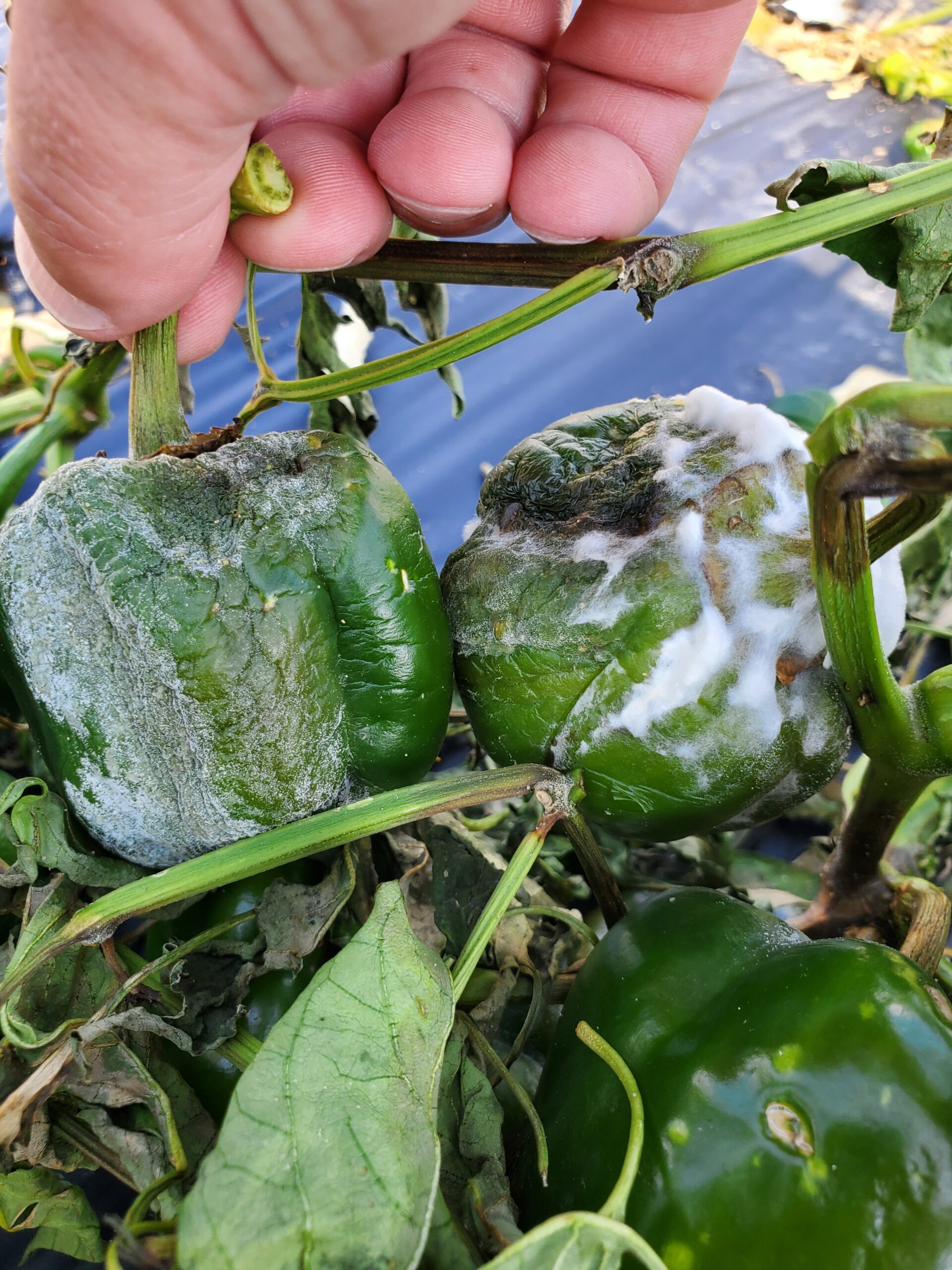Most of New Jersey has been plagued by heavy rains and pop-up thunderstorms these past few weeks making conditions ideal for pathogens such as Phytophthora blight (P. capsici) on pepper, eggplant, tomato, and cucurbit crops. Unfortunately, Phytophthora blight can be found on most farms in the southern part of the state. Poor crop rotations with susceptible hosts only make matters worse. The pathogen has an increasing host range that also includes snap and lima beans, and all crops, other than a few resistant bell pepper cultivars, lack any resistance to the pathogen.

Phytophthora-infected fruit (on left) and a pepper fruit with Pythium cottony leak (on right)
Control of Phytophthora blight is extremely difficult (even with the use of fungicides) in the wet weather conditions that most of New Jersey has been through during the month of June. In the past few years a number of new fungicides, with new active ingredients, have become commercially-available for use on multiple crops. Mefenoxam or metalaxyl, both once widely-used to effectively control Phytophthora blight has been hit by resistance issues around much of Southern New Jersey the past decade. Growers with a known history of mefenoxam-insensitivity on their farm should use Presidio or Ranman plus a Phosphite fungicide in rotation in their drip application programs. Importantly, if mefenoxam has not been used in particular fields on any crop for a number of years (more than 5+) the fungus may revert back to being mefenoxam-sensitive and control with these products may return. Mefenoxam, metalaxyl, and the phoshites are the most systemic of the group and should readily be taken up the by plant via application through the drip. Presidio has locally systemic and has translaminar activity and should offer some protection of the root system via drip. Ranman has protectant activity and thus will offer some root protection where it comes into contact with. As a note, in research trials at RAREC, mefenoxam, Presidio, Ranman, Revus and the phosphites in rotation and/or tank mixes have offered very good control of the fruit rot phase of phytophthora blight.
Recommendations for Controlling the Crown Rot Phase
Mefenoxam–1.0 pt Ridomil Gold 4SL/A or 1.0 qt Ultra Flourish 2E/A or metalaxyl (MetaStar)–4.0-8.0 pt 2E/A at transplanting and 30 days later, or
Presidio (fluopicolide, 43) at 3.0-4.0 fl. oz 4SC/A at transplanting and/or 14 days later (between two mefenoxam applications),
Ranman (cyazofamid, 21) at 2.75 fl oz 400SC at transplanting (Ranman may be added to transplant water, see label for restrictions) and/or 14 days later (between two mefenoxam applications)
Phosphite materials (FRAC code 33) such as Rampart, ProPhyt, K-Khite may also be tank mixed with one of the above to help suppress Phytophthora blight.
If mefenoxam-insensitivity is present, only use Presidio, Ranman, Revus, and/or phosphite fungicides.
For more information on these fungicides and specific crop use please see the 2015 Commercial Fungicide Recommendations Guide.
Recommendations for Organic Practices
Organic bell pepper growers with a history of the Phytophthora blight should plant bell pepper cultivars that have resistance or tolerance to the disease. Long non-host crop rotations are critically important for organic production. Regular applications of Double Nickel (Bacillus amyloliquefaciens) or Regalia (Extract of Reynoutria sachalinensis) as drenches or via the drip system prior to the onset of disease may help suppress Phytophthora blight development in susceptible crops. Rogueing out infected plants, making sure and allowing water to adequately drain out of field may help to suppress the disease.
Phytophthora Losses Already High?
If phytophthora losses have already started because of the heavy rains, pre-emptive cultural practices need be taken immediately. Rogueing out, discing under, and/or hitting areas with gramoxone to burn infected plants down will help slow down and/or reduce the spread of potential inoculum to healthier areas of the block or farm. If beds are chronically wet, plastic can be cut or completely removed to help soils dry out. Overhead irrigation should be avoided if not on drip irrigation to help prevent spread of aerial phase. All infected fruit need to be completely removed from field separately from normal picking.

